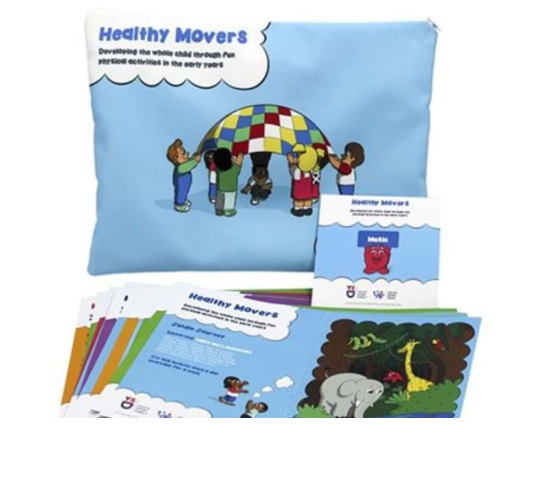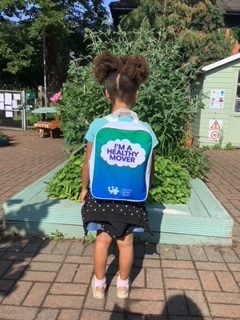- Working with Youth Sports Trust to deliver an evidence-based project ‘Healthy Movers’ project.
- Virtual training and network sessions.
- Resources for each setting.
- Project Management – administration time.
#567
Healthy Movers
The aim of the project was to help pre-school children in the Opportunity Area get the opportunity to achieve a good level of physical development linked to their language and literacy skills. In doing so, it increased the children’s self-esteem and wellbeing, developed their agility, balance, and co-ordination; this helps children gain a better start to their life, improve school readiness and, in time, social mobility.
Audience
Childminders, Settings & Early Years PractitionersAimed at
Early Years Foundation StageOutcome
Early Years, Language Development, Literacy, School ReadinessApproach
Whole SchoolWhy was the project needed?
Encouragingly, the percentage of children achieving a good level of development at the end of the Early Years Foundation Stage in Ipswich is in line with national average. However, the data showed that children from disadvantaged backgrounds consistently achieved lower levels of development than their non-disadvantaged peers. Disadvantaged children in Ipswich were also less likely to achieve an exceeded level in many of the individual early learning goals (ELGs).
School leaders reported that not all children began school having developed the behaviours they need to learn and fulfil their potential, such as agency, resilience and self-regulation. Research shows that our social and emotional development as children affects many of the things we care about in adult life, including adult physical and mental health, employment, and life satisfaction (Goodman et al. 2015).
A quarter of disadvantaged pupils in Ipswich did not meet the expected level in the speaking ELG and a fifth do not meet the expected level in the understanding ELG. We know that children who are behind in language development at age five are six times less likely to reach the expected standard in English at age eleven, and eleven times less likely to achieve the expected level in maths (Save the Children, 2016). The gap in early language development between disadvantaged children and their peers is often described as the ‘word gap’. The early years provides the one chance to close this gap to ensure disadvantaged children can enter school with the skills and language development they need to thrive, without immediately having to play catch up.
What happened and what was the impact?
The project was delivered to 8 Early Years Settings within the ‘Healthy Movers Framework’ Training was delivered virtually due to the constraints of Covid-19
Specific outputs
- Training on physical literacy delivered to early years practitioners in 8 early years settings
- Training on engaging parents in supporting their child’s physical literacy delivered to the same 8 early years settings
- Ongoing support for early years practitioners to enable them to share good practice, discuss any challenges/barriers and potential solutions.
- Toolkit to support early years practitioners increase physical literacy for each of the same 8 early years settings.
- Resources for every child in each of the 8 early years settings to support parents to support the development of their children’s physical literacy.
- Monitoring and evaluation report capturing the impact of the programme on practitioners and parents and any changes in children’s physical literacy levels between the start and end of the project.
Summary of evaluation:
- How has the training helped you feel more competent in your role: 71% helped a lot
- How has the training helped you feel more confidence in your role: 57% helped a lot
- How has the training helped you feel more motivated in your role: 57% helped a lot
- As a result of the training how likely is that you will make changes to the way you undertake your role. 43% very likely and 43% likely
What did and didn't work?
The project was a success. However due to Covid-19 and staffing changes, the project implementation happened within a much shorter window of time than originally planned. This mean that the turn around between each session was much quicker and did not allow settings enough time to be able to digest the training and take it away and implement before being invited back to a networking session. We were also unable to run any courses face-to-face and had to deliver each element via zoom. Whilst the virtual sessions were still successful and delivered by a lead tutor at the YST, the face-to-face interaction was definitely missing from this course and the opportunity for settings to try out each of the practical elements in a face-to-face environment rather than over a screen
How did you measure success?
Practitioners were surveyed at points during the project.
Wisdom
Ingredients For Success
Is the Project Complete or Ongoing
The project is complete but the learning has been embedded and cascaded and the resources are still being used within settings.
How is the Project Sustainable
Healthy Movers flexible delivery and simple resources has enabled it to be easily embedded into settings’ daily practice, this has helped to make it sustainable and all settings are reporting that they are likely to continue delivering Healthy Movers.
What are the Long Term Impacts
Practitioners in the settings report that they feel more confident in their ability to support children’s physical literacy in the early years and that participating children have made progress towards a good level of development as a result of the intervention. Parents report that they have a better understanding of the importance of children’s physical literacy in the early years, and the role it plays in school readiness, they also feel more confident in their own ability to support children’s physical literacy in the early years.
Area Most Impacted
Language Development Literacy School Readiness
Next steps to do something similar yourself
These are a list of Big Idea resources that you can use to implement in your setting:
Youth Sport Trust - Healthy Movers Factsheet
Youth Sport Trust -EY Physical Literacy Framework
Read the Youth Sport Trust Research here
Read the EEF Guidance Report on Preparing for Literacy here
Education Endowment Foundation - Preparing for Literacy Poster
Read the EEF Guidance Report on Social and Emotional Learning here
Read the EEF Guidance Report on Parental Engagement here
Champions and contacts
Authors



If you've got any thoughts and ideas of how this approach could be improved or an positive impact it's had for you, add them below
Login or register now to post any comments